View in other NatureServe Network Field Guides
NatureServe
Montana
Utah
Wyoming
Idaho
Wisconsin
British Columbia
South Carolina
Yukon
California
New York
North Idaho Monkeyflower - Mimulus clivicola
Other Names:
Diplacus clivicola
State Rank Reason (see State Rank above)
See rank details.
- Details on Status Ranking and Review
Population Size
Score2-3 - Very Small to Small: Population size is imprecisely known but is believed to be <10,000 individuals.
Range Extent
Score2 - Regional or State Endemic or Small Montana Range: Generally restricted to an area <100,000 sq. miles (equivalent to 2/3 the size of Montana or less) or Montana contributes 50% or more of the species’ range or populations OR limited to 2-3 Sub-basins in Montana.
Area of Occupancy
Score3 - Very Low: Generally occurring in 3 or fewer Subwatersheds (6th Code HUC’s).
Environmental Specificity
Score1-2 - Moderate to High.
Trends
ScoreNA - Rank factor not assessed.
CommentTrends are unknown as populations were only recently discovered in Montana, though significant declines probably have not occurred.
Threats
Score0-3 - Threats levels are Unknown.
CommentPotential threats are undocumented. However, species appears to need some level of disturbance for germination.
Intrinsic Vulnerability
Score1-2 - Moderate to High Vulnerability.
Raw Conservation Status Score
Score
9 to 15 total points scored out of a possible 16 (Rarity factors and threats only).
General Description
PLANTS: An annual with ascending to erect, mostly simple stems that grow from 3 to 10 cm tall. Plants have glandular-pubescent hairs. Source: Lesica et al. 2012.
LEAVES: Leaves are simple, sessile, and arranged opposite on the stem. Leaf blades are oblong with entire margins and are usually about 1 cm long. Source: Lesica et al. 2012.
INFLORESCENCE: Few-flowered, but showy purple flowers that grow on long stems (pedicels) from the upper leaf axils. Source: Giblin et al. [eds.] 2018; Lesica et al. 2012.
The specific epithet clivicola is a combination of the Latin words clivus and cola meaning “slope” and “dwelling place” respectively and referring to its preferred habitat on wooded slopes. Mimulus is derived from the Latin word mime, meaning “actor” or “mimic,” and the male diminutive -ulus (Merrium-Webster 2019). This is most likely referring to the mask-like appearance of the flowers.
Phenology
North Idaho Monkeyflower flowers from May through August (Nesom in Flora of North America 2012).
Diagnostic Characteristics
Montana has 5 native
Mimulus species with purplish flowers, of which 2 are perennial and 3 are annual plants. In Montana
Mimulus species have opposite, simple leaves, and in the axils of upper leaves grow pairs of stemmed flowers. Flowers have 5-petals and 5-sepals, are bilaterally symmetrical, and are tubular.
North Idaho Monkeyflower-
Mimulus clivicola *Habit: Plants are annuals, often less than 10 cm tall.
*Herbage: Glandular-pubescent.
*Leaves: Sessile, oblong, entire, and about 1 cm long.
*Flowers: The corolla is 10-15 mm long, purple and bilabiate with unequal lobes and a yellow-spotted palate.
*Capsule: The mature capsule is 5-8 mm long and tubular.
Dwarf Purple Monkeyflower-
Mimulus nanus*Habit: Planta are annual, often less than 10 cm tall.
*Herbage: Glandular-puberulent.
*Leaves: Petiolate below and sessile above, oblanceolate, entire, and 5 to 15 mm long.
*Flowers: The corolla is 1-2 cm long, magenta and bilabiate with a yellow-spotted palate.
*Capsule: The mature capsule is 7-11 mm long.
Brewer's Monkeyflower-
Mimulus breweri *Habit: Plants are annuals, often less than 15 cm tall.
*Herbage: Stalked-glands (stipitate glandular).
*Leaves: Narrow blades (lanceolate) with entire margins (smooth), stemmed (petiolate), and 5-20 mm long.
*Flowers: The calyx is purplish. The corolla is 5-10 mm long, purple to red, and slightly bilabiate.
*Capsule: The mature capsule is 5-7 mm long.
Square-stem Monkeyflower-
Mimulus ringens*Habit: Plants are mat-forming, rhizomatous perennials, often more than 15 cm tall.
*Herbage: None (glabrous).
*Leaves: Sessile, lanceolate to oblanceolate, serrate, and 2-8 cm long.
*Flowers: The corolla is 20-27 mm long, purple, and bilabiate with a bearded palate.
*Capsule: The mature capsule is 10-12 mm long.
Lewis’ Monkeyflower-
Mimulus lewisii*Habit: Plants are rhizomatous perennials, often more than 15 cm tall.
*Herbage: Almost glabrous (glabrate) to glandular-pubescent.
*Leaves: Sessile to subsessile, lanceolate to ovate, serrate, and 1-7 cm long.
*Flowers: The corolla is 3-5 cm long, bilabiate, pink-purple or magenta with a yellow and purple-spotted palate.
*Capsule: The mature capsule is 12-16 mm long.
Species Range
Montana Range
Range Descriptions
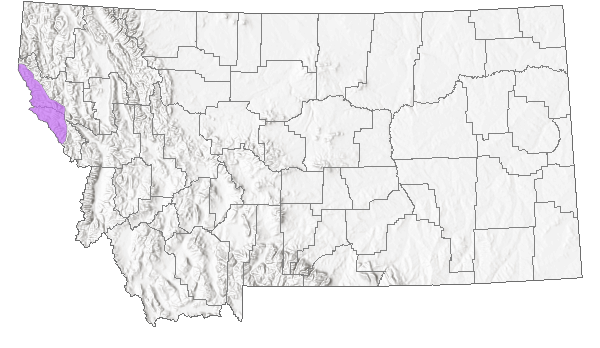
 Native
Native
Range Comments
North Idaho Monkeyflower can be found in eastern Washington, Oregon, northern Idaho, and northwest Montana (Giblin et al. [eds.] 2018). It is considered endemic to the interior Pacific Northwest (Lorain et al. 1989).
Observations in Montana Natural Heritage Program Database
Number of Observations: 16
(Click on the following maps and charts to see full sized version)
Map Help and Descriptions
Relative Density
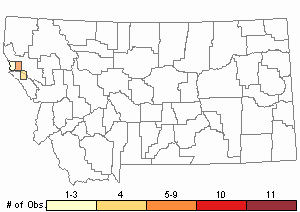
Recency
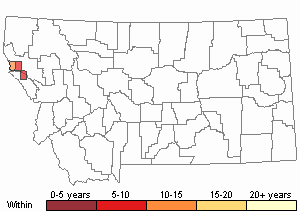
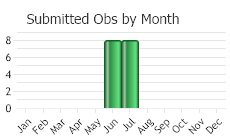
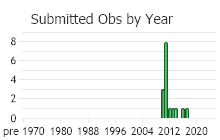
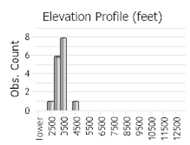 (Observations spanning multiple months or years are excluded from time charts)
(Observations spanning multiple months or years are excluded from time charts)
Habitat
North Idaho Monkeyflower prefers vernally moist soil of partially wooded slopes in montane zones in Montana (Lesica et al. 2012). Nearly all known populations are found on south and southwest facing aspects (Lorain et al. 1989)
National Vegetation Classification System Groups Associated with this Species
Forest and Woodland
Montane - Subalpine Forest and Woodland
Ecology
ASSOCIATED SPECIESNorth Idaho Monkeyflower can often be found under a canopy of Ponderosa Pine (
Pinus ponderosa), Douglas Fir (
Pseudotsuga menziesii), or Grand Fir (
Abies grandis) with an understory dominated by grasses or shrubs including Idaho Fescue (
Festuca idahoensis) and Western Redcedar (
Thuja plicata (Lorain et al. 1989). Other common herbaceous associates include Mallow-leaf Ninebark (
Physocarpus malvaceus), Narrow-leaved Collomia (
Collomia linearis), Large-flower Clarkia (
Clarkia pulchella), Lanceleaf Stonecrop(
Sedum lanceolatum), Bracken Fern (
Pteridium aquilinum), Small-flower Blue-eyed Mary (
Collinsia parviflora), Common Yarrow (
Achillea millefolium), Bluebunch Wheatgrass (
Agropyron spicatus), and Clasping-leaf Venus’-looking-glass (
Triodanis perfoliata) (Lorain et al. 1989). North Idaho Monkeyflower populations are also commonly seen with the noxious weeds Spotted Knapweed (
Centaurea stoebe) and Common St. John’s-wort (
Hypericum perforatum) (Lorain et al. 1989).
MICROCLIMATENorth Idaho Monkeyflower individuals can often be found in moist microhabitats such as seepages and small channels that are created from spring rain events (Lorain et al. 1989). Depressions of exposed mineral soil caused by elk and deer tracks also create favorable conditions for this species to germinate in (Lorain et al. 1989). Their location on steep slopes and in disturbed animal tracks also suggests that North Idaho Monkeyflower thrives in highly erosive soil conditions (Lorain et al. 1989). While moderate levels of disturbance are favorable to create these conditions, heavy disturbance is not tolerated (Meinke 1995).
POLLINATIONThe primary pollinators of North Idaho Monkeyflowers are small, usually ground-nesting bees (Meinke 1995). Small lepidopterans may be secondary pollinators. This species is also capable of limited self-pollination.
POLLINATORS The following animal species have been reported as pollinators of this plant species or its genus where their geographic ranges overlap:
Bombus vagans,
Bombus bifarius,
Bombus centralis,
Bombus flavifrons, and
Bombus pensylvanicus (Thorp et al. 1983, Colla and Dumesh 2010).
Reproductive Characteristics
FLOWERS
The mature flowers of North Idaho Monkeyflower have a 10 to 15 mm long, purple corolla that is bilabiate with unequal lobes and yellow marks on the palate (Lesica et al. 2012). The calyx is 6 to 8 mm long with 1 to 2 mm long, subequal teeth. Pedicels are shorter than the calyx.
FRUITS
The mature fruits are tubular capsules, 5 to 8 mm long, and many-seeded (Lesica et al. 2012).
LIFE CYCLE
North Idaho Monkeyflower is an annual plant (Lesica et al. 2012). It relies on spring moisture for seed germination and maturation (Lorain et al. 1989). Flowering follows from late spring to late summer (Nesom in flora of North America 2012). The seedbank plays an important role in population persistence. Individual seeds remain viable until conditions are favorable for germination (Lorain et al. 1989). While favorable climatic conditions determine flowering success in a given year, they are not so important for North Idaho Monkeyflower’s long term success on account of the persistent and selective seedbank.
Management
Plants can occur on steep, moist roadsides. Within its known range, roadsides along proposed road construction and maintenance activities should assessed for impacts on both North Idaho Monkeyflower habitat and existing populations (Lorain et al. 1989). Surveys for noxious weeds and their control should also be part of the assessment.
Due to its endemic nature and the unknown extent of the seedbank, continued monitoring is essential to assessing status of this species in northern Idaho (Lorain et al. 1989).
Stewardship Responsibility
Threats or Limiting Factors
Road construction, damming, exotic weeds, and recreational disturbances have cause extirpations of North Idaho Monkeyflower in Idaho (Lorain et al. 1989). Road construction activities often have the compounding effect of weed introduction. Several highly competitive weeds including Spotted Knapweed (Centaurea stoebe) and Cheatgrass (Bromus tectorum) have invaded North Idaho Monkeyflower habitat. Attempted chemical control of these invaders may cause additional threats especially due to the moist nature of the soil during early reproductive stages (Caicco 1987). Changing fire regimes may also pose a moderate threat to North Idaho Monkeyflower (Meinke 1995).
STATE THREAT SCORE REASON
Threat impact not assigned because threats are not known (MTNHP Threat Assessment 2021).
References
- Literature Cited AboveLegend:
 View Online Publication
View Online Publication Colla, S.R. and S. Dumesh. 2010. The bumble bees of southern Ontario: notes on natural history and distribution. Journal of the Entomological Society of Ontario 141:39-68.
Colla, S.R. and S. Dumesh. 2010. The bumble bees of southern Ontario: notes on natural history and distribution. Journal of the Entomological Society of Ontario 141:39-68. Lesica, P., M.T. Lavin, and P.F. Stickney. 2012. Manual of Montana Vascular Plants. Fort Worth, TX: BRIT Press. viii + 771 p.
Lesica, P., M.T. Lavin, and P.F. Stickney. 2012. Manual of Montana Vascular Plants. Fort Worth, TX: BRIT Press. viii + 771 p. MTNHP Threat Assessment. 2021. State Threat Score Assignment and Assessment of Reported Threats from 2006 to 2021 for State-listed Vascular Plants. Botany Program, Montana Natural Heritage Program, Helena, Montana.
MTNHP Threat Assessment. 2021. State Threat Score Assignment and Assessment of Reported Threats from 2006 to 2021 for State-listed Vascular Plants. Botany Program, Montana Natural Heritage Program, Helena, Montana. Thorp, R.W., D.S. Horning, and L.L. Dunning. 1983. Bumble bees and cuckoo bumble bees of California (Hymenoptera: Apidae). Bulletin of the California Insect Survey 23:1-79.
Thorp, R.W., D.S. Horning, and L.L. Dunning. 1983. Bumble bees and cuckoo bumble bees of California (Hymenoptera: Apidae). Bulletin of the California Insect Survey 23:1-79.
- Additional ReferencesLegend:
 View Online Publication
View Online Publication
Do you know of a citation we're missing? Lesica, P., M.T. Lavin, and P.F. Stickney. 2022. Manual of Montana Vascular Plants, Second Edition. Fort Worth, TX: BRIT Press. viii + 779 p.
Lesica, P., M.T. Lavin, and P.F. Stickney. 2022. Manual of Montana Vascular Plants, Second Edition. Fort Worth, TX: BRIT Press. viii + 779 p.
- Web Search Engines for Articles on "North Idaho Monkeyflower"





